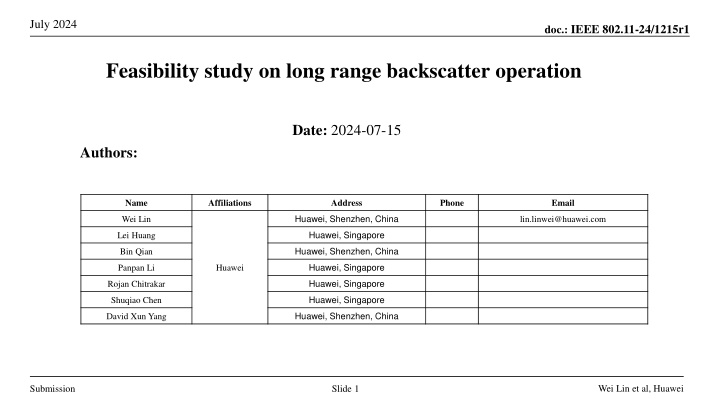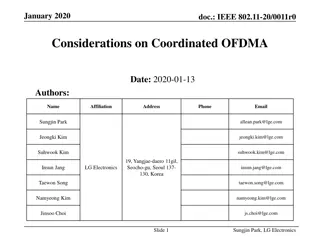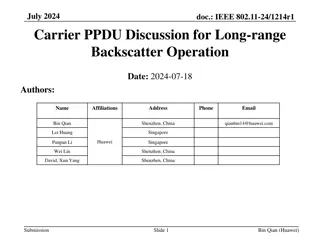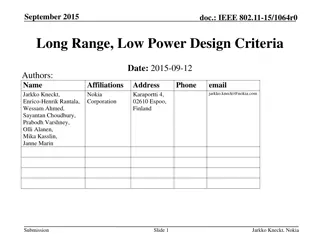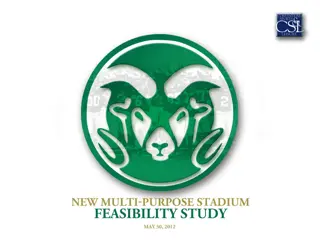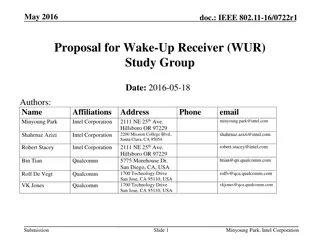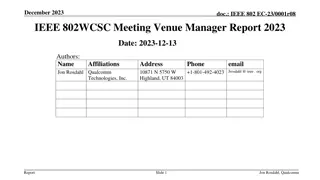Feasibility Study on Long-Range Backscatter Operation for IEEE 802.11-24
This document from July 2024 discusses the feasibility of long-range backscatter operation for IEEE 802.11-24, focusing on close-range and long-range backscatters in mono-static and bi-static setups. It evaluates the link budgets, downlink link budgets, and the use cases for both operations, emphasizing the need for further investigations to clarify the feasibility for medium to long range backscatters at 2.4GHz frequency.
Download Presentation

Please find below an Image/Link to download the presentation.
The content on the website is provided AS IS for your information and personal use only. It may not be sold, licensed, or shared on other websites without obtaining consent from the author.If you encounter any issues during the download, it is possible that the publisher has removed the file from their server.
You are allowed to download the files provided on this website for personal or commercial use, subject to the condition that they are used lawfully. All files are the property of their respective owners.
The content on the website is provided AS IS for your information and personal use only. It may not be sold, licensed, or shared on other websites without obtaining consent from the author.
E N D
Presentation Transcript
July 2024 doc.: IEEE 802.11-24/1215r1 Feasibility study on long range backscatter operation Date: 2024-07-15 Authors: Name Affiliations Address Phone Email Huawei, Shenzhen, China Wei Lin lin.linwei@huawei.com Huawei, Singapore Lei Huang Huawei, Shenzhen, China Bin Qian Huawei, Singapore Panpan Li Huawei Huawei, Singapore Rojan Chitrakar Huawei, Singapore Shuqiao Chen Huawei, Shenzhen, China David Xun Yang Wei Lin et al, Huawei Submission Slide 1
July 2024 doc.: IEEE 802.11-24/1215r1 Recap of Close Range & Long Range Backscatters There are two different backscatter use cases have been discussed in AMP [1-4] Close range backscatter Mono-static: the Carrier Source and AP are integrated Wi-Fi transceiver has 2+ antennas to support full-duplex operation Coverage: 10 cm - 20 cm Long range backscatter Bi-static: the Carrier Source and AP are separated, which results in half duplex operation Coverage: several meters Leakage signal Close range backscatter [4] Long range backscatter Wei Lin et al, Huawei Submission Slide 2
July 2024 doc.: IEEE 802.11-24/1215r1 Close Range & Long Range Backscatters According to the SP results during last IEEE meeting, it seems that the group in favor of the use case of close range backscatter operation [7] The feasibility of close range backscatter operation have been extensively investigated in [1-4] Ref [1] [5] have addressed long range backscatters, but further investigations are required to clarify the feasibility for medium/long range backscatters at 2.4GHz frequency. In this contribution, we investigate the feasibility for backscatter operation of around 10~15m coverage Considered Use Case: Long range backscatter with separated Carrier Source and AP Wei Lin et al, Huawei Submission Slide 3
July 2024 doc.: IEEE 802.11-24/1215r1 Link Budget for Long Range Backscatters The link budget computations were extensively discussed in [3-6] To evaluate the feasibility of long range backscatter, we further investigate the link budgets of Bi-Static long range backscatter with separated Carrier Source and AP The AMP Tag in this case should have some power storage or WPT capabilities better sensitivity Both Friis equation and 11n defined channel models (2.4GHz) are evaluated Friis equation Long range backscatter 11n channel model Wei Lin et al, Huawei Submission Slide 4
July 2024 doc.: IEEE 802.11-24/1215r1 Downlink Link Budget for Long Range Backscatters Downlink link budget computations of Bi-Static long range backscatters The Tx/Rx signal isolation is greatly alleviated with separated Carrier Source and AP Pr = Pt + Gt + Gr + 20log10( ) 20log10(4 d) (with Friis Equation) Bi-Static long range backscatter Antenna gain of AMP Tag (dBi) Minimum receiving power for AMP Tag (dBm) Frequency EIRP of AP (dBm) Max. commun. distance from AP to AMP Tag (m) (Friis) Max. commun. distance from AP to AMP Tag (m) (11n Channel D) 2 -45 2.4 GHz 27 49.85 17.8 20 22.27 11.32 Wei Lin et al, Huawei Submission Slide 5
July 2024 doc.: IEEE 802.11-24/1215r1 Uplink Link Budget for Long Range Backscatters Uplink link budget computations of Bi-Static long range backscatters at 2.4GHz Frequency The Tx/Rx signal isolation is greatly alleviated with separated Carrier Source and AP Pr = Pt + Gt + Gr + 20log10( ) 20log10(4 d) (with Friis Equation) Carrier Source to AMP Tag EIRP of Carrier Source (dBm) 27 20 Antenna gains of AMP Tag (dBi) 2 Minimum receiving power for AMP Tag (dBm) -20 Max. commun. distance from Carrier Source to AMP Tag (m) (Friis) 2.80 1.25 2 0.88 Max. commun. distance from Carrier Source to AMP Tag (m) (11n Channel D) AMP Tag to AMP Reader Receiver sensitivity of AP (dBm) -95 -20 Maximum transmission power of AMP Tag (dBm) Backscattering loss at AMP Tag (dB) 5 Max. commun. distance from AMP Tag to AP (m) (Friis) 49.85 17.94 Max. commun. distance from AMP Tag to AP (m) (11n Channel D) Wei Lin et al, Huawei Submission Slide 6
July 2024 doc.: IEEE 802.11-24/1215r1 Uplink Link Budget for Long Range Backscatters Uplink link budget computations of Bi-Static long range backscatters at 2.4GHz Frequency The Tx/Rx signal isolation is greatly alleviated with separated Carrier Source and AP Pr = Pt + Gt + Gr + 20log10( ) 20log10(4 d) (with Friis Equation) Carrier Source to AMP Tag EIRP of Carrier Source (dBm) 27 20 Antenna gains of AMP Tag (dBi) 2 Minimum receiving power for AMP Tag (dBm) -25 Max. commun. distance from Carrier Source to AMP Tag (m) (Friis) 4.98 2.22 3.50 1.56 Max. commun. distance from Carrier Source to AMP Tag (m) (11n Channel D) AMP Tag to AMP Reader Receiver sensitivity of AP (dBm) -95 -25 Maximum transmission power of AMP Tag (dBm) Backscattering loss at AMP Tag (dB) 5 Max. commun. distance from AMP Tag to AP (m) (Friis) 28.03 12.91 Max. commun. distance from AMP Tag to AP (m) (11n Channel D) Wei Lin et al, Huawei Submission Slide 7
July 2024 doc.: IEEE 802.11-24/1215r1 Summary In this contribution, we investigated the feasibility for long range backscatter operation of around 10~15m coverage Considered Use Case: Long range backscatter with separated Carrier Source and AP According to the downlink / uplink link budget evaluations, it is feasible for long range backscatter operations of around 10~15m coverage Wei Lin et al, Huawei Submission Slide 8
July 2024 doc.: IEEE 802.11-24/1215r1 Thank You Wei Lin et al, Huawei Submission Slide 9
July 2024 doc.: IEEE 802.11-24/1215r1 Straw Poll Do you support that 11bp defines at least one mode of MAC/PHY that supports long-range backscattering communication in 2.4 GHz as shown below Wei Lin et al, Huawei Submission Slide 10
July 2024 doc.: IEEE 802.11-24/1215r1 References [1] 11-24-0853-00-00bp-design-target-and-device-capabilities-for-amp-iot [2] 11-24-0867-00-00bp-thoughts-and-questions-on-amp-phy [3] 11-23-2038-01-0amp-close-range-amp-backscattering-in-2-4ghz [4] 11-24-0798-01-00bp-close-range-amp-wifi-reader-feasibility-study-followup [5] 11-24-0075-00-0amp-follow-up-on-amp-link-budgets [6] 11-22-1562-08-0amp-draft-technical-report-on-support-of-amp-iot-devices-in-wlan [7] 11-24-0953-00-00bp-2024-05-interim-meeting-minutes Wei Lin et al, Huawei Submission Slide 11
